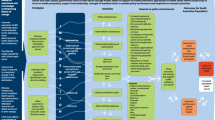Abstract
Program planning and evaluation are critical steps in using a population health approach. This paper outlines how logic models have been adapted within a health promotion framework to guide public health programs and facilitate program description. It is important that we take the time to describe clearly what we are doing, reflect on practice and elaborate the conceptual base for the new public health programs so that we can evaluate the impact of our work. Ongoing research is required to identify appropriate and measurable indicators that capture the process, as well as the outcome, of population-based health promotion.
Résumé
La planification et l’évaluation de programmes constituent des étapes importantes d’une approche axée sur la santé de la population. Ce document décrit comment les modèles de logique ont été adaptés à un contexte de promotion de la santé afin de servir de guide aux programmes de santé publique et de faciliter la description des programmes. Il est important que nous prenions le temps de décrire clairement ce que nous faisons, de réfléchir sur la pratique et d’élaborer la base conceptuelle des nouveaux programmes de santé publique; nous pourrons, de cette manière, évaluer l’impact de notre travail. La recherche continue est nécessaire afin d’identifier les indicateurs appropriés et mesurables qui cernent le processus, ainsi que le résultat, de la promotion de la santé axée sur la population.
Similar content being viewed by others
References
Chambers LW, Underwood J, Halbert T, et al. 1992 Ontario survey of public health nurses: Perceptions of roles and activities. Can J Public Health 1994; 85(3):175–79.
Murphy M, Dunkley G, Edwards N, et al. Shifting public health programs to foster supportive environments: Professionals and services in transition. Canadian Public Health Association Conference, Yellowknife, NWT, July 1992.
World Health Organization, Health and Welfare Canada, and Canadian Public Health Association. Ottawa Charter for Health Promotion. Can J Public Health 1986; 77(6):425–27.
McKinlay JB. The promotion of health through planned socio-political change: Challenges for research and practice. Soc Sci Med 1993; 36(2):109–17.
Mustard F, Frank J. The Determinants of Health. CIAR Publication No. 5. Toronto: Canadian Institute of Advanced Research, 1991.
Premier’s Council on Health, Well-being and Social Justice. Nurturing Health. Toronto: Queen’s Printer for Ontario, 1993.
Ontario Ministry of Health. Mandatory Health Programs and Services Guidelines. Ottawa: Queen’s Printer for Ontario, 1989.
Ontario Ministry of Health. Healthy Growth and Development. Healthy Elderly: Principles and Program Strategies. Ottawa: Ministry of Health, 1991.
Ottawa-Carleton Health Department Adult Directorate Strategic Plan: 1991–1994. Regional Municipality of Ottawa-Carleton, Ottawa, Ontario, 1995.
Ottawa-Carleton Health Department Strategic Plan, 1994–1997. Regional Municipality of Ottawa-Carleton, Ottawa, Ontario, 1994.
Edwards N, Murphy M, Moyer A, et al. Building and sustaining collective health action: A framework for community health practitioners. Community Health Research Publication No. DP95-1, 1995.
Green LW, Kreuter MW. Health Promotion Planning: An Educational and Environmental Approach, 2nd edition. Mountain View: Mayfield Publishing, 1991.
Suchman E. Evaluative Research: Principles and Practice in Public Service and Social Action Programs. New York: Russell Sage Foundation, 1967.
Weiss C. Evaluation Research: Methods for Assessing Program Effectiveness. Englewood Cliffs, NJ: Prentice-Hall, 1972.
Wholey JS. Evaluability assessment. In: Rutman L (Ed.), Planning Useful Evaluations: Evaluability Assessment. Beverly Hills, CA: Sage Publications, 1977.
Wholey JS. Evaluation and Decision Making for Health Services, 2nd edition. Ann Arbor, MI: Health Administration Press, 1983.
Corbeil R. Improving federal evaluation and planning. Can J Program Evaluation 1989; 4:23–28.
Rutman L. Evaluability assessment: Program analysis. In: Rutman L (Ed.), Planning Useful Evaluations: Evaluability Assessment. Beverly Hills, CA: Sage Publications, 1980.
Rush B, Ogborne A. Program logic models: Expanding their role and structure for program planning and evaluation. Can J Program Evaluation 1991; 6(2):95–106.
Baskerville B, Stewart P. Program evaluation workshop. Ottawa-Carleton Health Department, February 1991.
Author information
Authors and Affiliations
Corresponding author
Rights and permissions
About this article
Cite this article
Moyer, A., Verhovsek, H. & Wilson, V.L. Facilitating the Shift to Population-based Public Health Programs: Innovation Through the Use of Framework and Logic Model Tools. Can J Public Health 88, 95–98 (1997). https://doi.org/10.1007/BF03403869
Received:
Accepted:
Published:
Issue Date:
DOI: https://doi.org/10.1007/BF03403869




